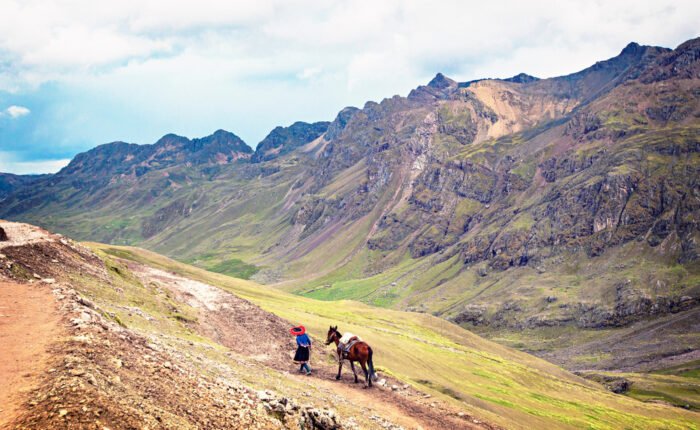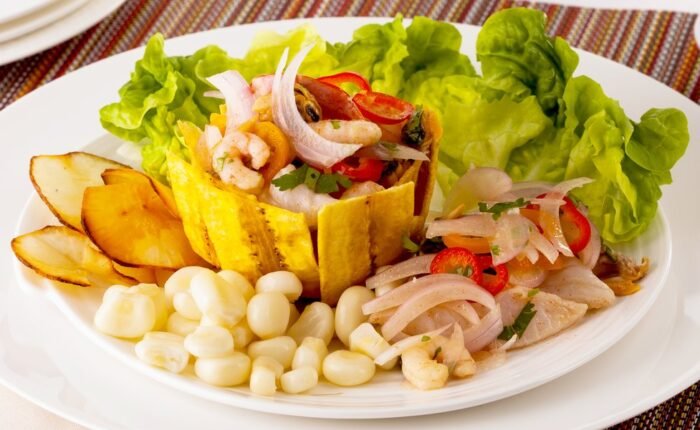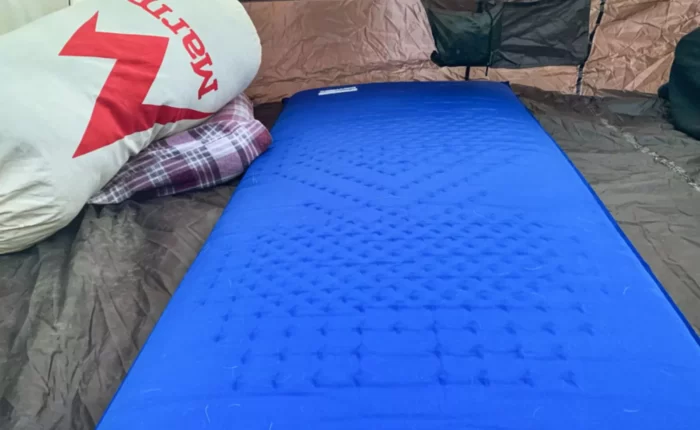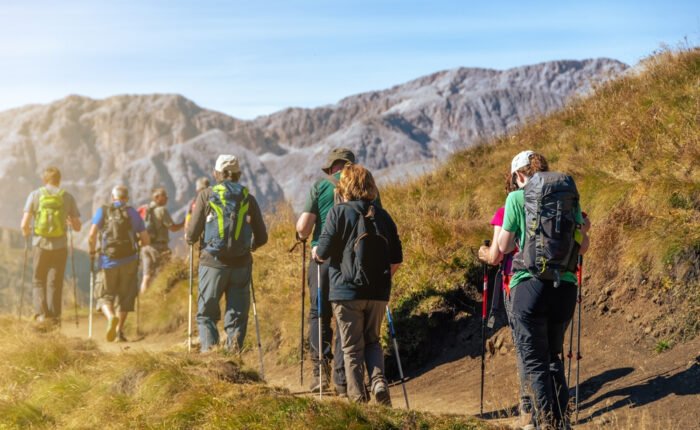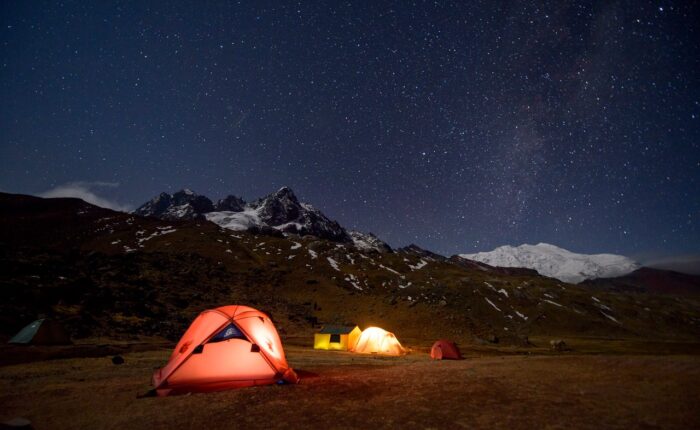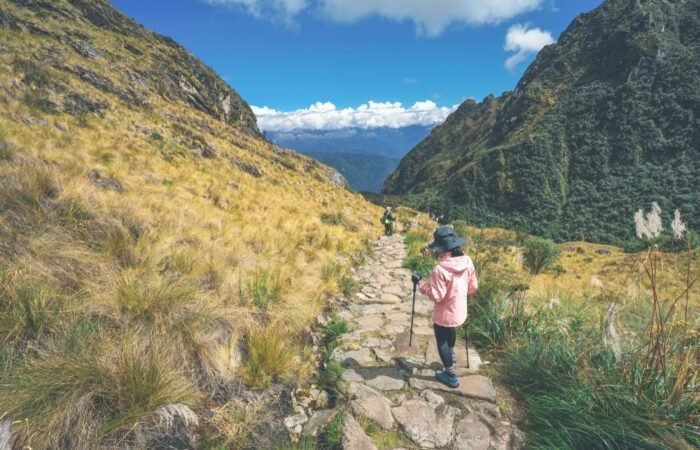


Ausangate is one of the highest mountains in the Cusco region and is also an important cultural centre for the Andean communities. Every year huge pilgrimages are made to the mountain. This has been going on for centuries.The peak of the mountain is 6,385 masl, but we won’t go quite that high. On this hike you’ll come close to nature and feel the connection while you observe the impressive views that surround you. You’ll get to observe some fascinating bird species and other wildlife along the way as well as spectacular landscapes.
Unlike other hikes, this is more about nature and its beauty rather than Inca ruins. This is a quieter trek in the Cusco region and you can enjoy peace and tranquility. It’s perfect for those who love outdoor trekking adventures.
Ausangate is one of the highest mountains in the Cusco region and is also an important cultural centre for the Andean communities. Every year huge pilgrimages are made to the mountain. This has been going on for centuries.The peak of the mountain is 6,385 masl, but we won’t go quite that high. On this hike you’ll come close to nature and feel the connection while you observe the impressive views that surround you. You’ll get to observe some fascinating bird species and other wildlife along the way as well as spectacular landscapes.
Unlike other hikes, this is more about nature and its beauty rather than Inca ruins. This is a quieter trek in the Cusco region and you can enjoy peace and tranquility. It’s perfect for those who love outdoor trekking adventures.
There are various tours heading to the Ausangate Mountain. Some can be combined with a visit to Rainbow Mountain or other sites. You can read more about your options here.
Ausangate trek is one of the most beautiful circuits to explore with impressive views and landscapes.

All of our horsemen are from Upis, which is the starting point of our trek. We make sure to employ responsible people that are serious about what they do. This way, they do an excellent job at transporting everyone’s items along the trail with mules and are in charge of getting your gear safely to each campsite where it will be waiting for you.
Our horsemen are very content with us receiving a good salary and benefits at the end of each season. Peru Hike provides all the mountain gear and uniforms to the horsemen. These guys can be of great help in an emergency because they know the area and trail like the back of their hand.

Peru Hike relies on an extensive network of highly trained guides and expert ambassadors as a premise to guarantee excellence in our services. We are fully conscious that an excellent guide is key to making your trip a memorable
experience, which is why we are extremely demanding when recruiting and regularly training our guides.
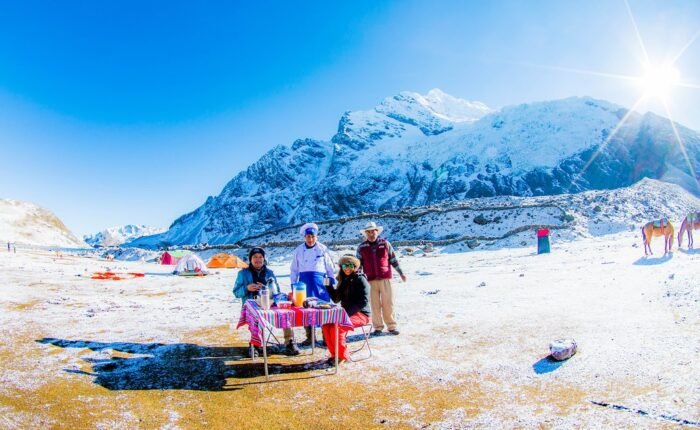
In all of our trekking trips, the chef ensures high-quality meals on time, an adequate diet both in its quality and quantity. The secret lies in the careful selection of our team of chefs, whose top-quality restaurant background,
creativity and passion for their jobs provide an unequalled touch to all of our meals. We do not have set menus since we wish to give our chefs the chance to create, innovate and surprise our clients through delicious dishes in every
trip.
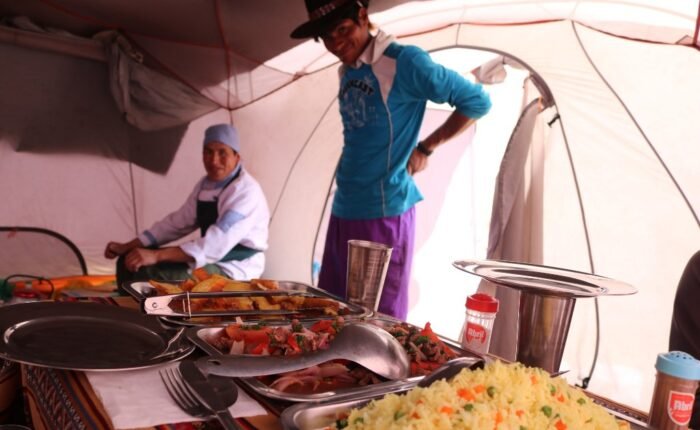
We do not have set menus since we wish to give our chefs the chance to create, innovate and surprise our clients through delicious dishes in every trip. We provide general guidelines, guest information on dietary restrictions and
preferences and, most especially, the tools for a constant updating of our cooks’ knowledge in both Peruvian and International cuisine through specialization courses and training.

Enjoy a good night’s sleep in our spacious Eureka tent. All our tents are built to be four man tents, but you will only have to share with one other trekker. This leaves a lot of room to spread out comfortably and store your duffels.
They are an A-frame design, with entrances on both sides of the tent. They also include a vestibule in front, giving you some extra outdoor space to leave your boots and walking sticks. We are proud to be the only company to use these
tents.
Before You Go, What You Should Know
Here are the top highlights that you’ll enjoy on the excursion:
One of the things that makes this trek more challenging is the altitude. You’ll reach Condor Pass at 5,400 masl, so you need to make sure you’ve prepared for the high elevation in advance. You can do this by arriving in Cusco a few days before to acclimate. Failing to take this into consideration could leave you feeling sick on the trek or even unable to go.
There’s no doubt that on this trek through the Andean mountains you’ll see some incredible sights. Expect to see lakes, snowy mountain peaks, and rolling hills. Don’t forget your camera to capture it all.
The weather in the mountains can change a lot. In the days you’ll feel the sun beating on your face. Make sure you use a lot of protection from it as you’re much closer to it up here. In the nights it will get chilly, so make sure you have the right clothing. It may also rain, so a lightweight poncho is a must in your backpack.
Being away from the city means you’ll be going back to basics. You’ll be camping along the route, so won’t have proper bathrooms or showers. In some spots you’ll find places to buy water and maybe some simple snacks, but it’s best to take enough with you from the start.
Even though this trek isn’t the most difficult in the region, you’ll be walking long distances at high altitude. The days can feel long, so know that you’ll feel tired along the way.
Now for a few facts about this adventurous trek.
The Ausangate trek is considered vigorous, with some moderate days. The trek is rated Grade moderately challenging in difficulty, which involves altitudes between 14,800 and 16,400 ft (4,500-5,000 m) and 6-7 hours of walking per day. Many of the days have steep sections that cause a rapid increase in altitude in a short time. Anyone with a good level of fitness can manage this trek, but it is recommended that hikers have experience of multi-day treks at high altitudes.
Another factor to consider, besides the steep sections and lift passes over 16,000 feet, is the weather. The weather can be quite unpredictable, and blizzard conditions at the higher altitudes are not uncommon. It is important to take into account low temperatures and tolerance to cold and snow.
The Ausangate mountain is located in the southeastern region of Peru, in the Cusco region. It is part of the Vilcanota mountain range and is surrounded by several other peaks, including Mariposa, Colquecruz, Pucapunta, and Jatunmontepuncu.
The region surrounding Ausangate is known for its rugged and remote landscape, with deep valleys, high altitude plateaus, and glacial lakes. The mountain itself is covered in glaciers and snow, and several rivers originate from its slopes, including the Vilcanota, Apurimac, and Paucartambo rivers.
The Ausangate trek takes hikers through this spectacular landscape, passing by alpine lakes, high altitude grasslands, and traditional Quechua-speaking communities. The area is also home to a diverse array of flora and fauna, including vicuñas, llamas, alpacas, and Andean condors.
Due to its high altitude and remote location, the Ausangate region experiences variable weather conditions, including heavy rain and snow, as well as bright sunshine and clear skies. The best time to visit the region is during the dry season, which runs from May to September.
In general, the Ausangate walk is carried out normally all year round, but keep in mind that in the months of October to April we will have rainy, snowy or sunny days.
Ausangate is a mountain located in the Andes range of Peru. It is situated in the Cusco region, approximately 100 kilometers southeast of the city of Cusco. The mountain is part of the Vilcanota mountain range and has a peak elevation of 6,384 meters (20,945 feet). The Ausangate region is known for its rugged and remote landscape, glacial lakes, snow-capped peaks, and indigenous communities that have preserved their traditional way of life for centuries. The Ausangate trek is a popular trekking route that takes hikers through this spectacular region, providing stunning views of the Andes Mountains and a glimpse into the culture and traditions of the Quechua-speaking communities that call the area home.
The distance of the Ausangate trek can vary depending on the specific route taken and the starting point. Generally, the trek is around 70-75 kilometers (43-46 miles) long and takes 5 to 8 days to complete. The trek usually starts in Upis and ends in the small town of Pacchanta or Tinqui, which is located approximately 100 kilometers (62 miles) southeast of the city of Cusco.
Please note that the Ausangate circuit starting in Upis and ending in the small village of Pacchanta or Tinki, 5 to 8 days has a distance of 70-75 kilometers (43-46 miles), and the treks starting in Upis and ending in the rainbow mountain, 3 to 4 days have an approximate distance of 35 km (21 miles).
The trek takes hikers through a variety of terrain, including high-altitude grasslands, snow-capped peaks, and glacial lakes. The route includes steep ascents and descents, rocky terrain, and variable weather conditions.
While the distance may not be as long as other popular trekking routes, such as the Inca Trail, the Ausangate trek is still a challenging trek due to its high altitude and rugged terrain. Hikers should be prepared for the physical demands of the trek and acclimatize properly before starting the journey.
The Ausangate mountain is considered a sacred site by the Andean people and has been revered for thousands of years. The Quechua-speaking communities that live in the region have passed down stories and legends about the mountain from generation to generation.
During the Inca Empire, the Ausangate mountain was also considered a sacred site and was incorporated into the empire’s extensive network of roads and trails. The Inca people used the area for religious ceremonies, and it was believed to be a place of spiritual renewal.
After the Spanish conquest of the Inca Empire in the 16th century, the region became more isolated and the indigenous communities were able to maintain their traditional way of life. Today, the Ausangate trek is a popular hiking route that passes through these communities, providing a glimpse into their culture and way of life.
In recent years, the Ausangate region has become increasingly popular among tourists seeking an alternative trekking route to Machu Picchu. However, efforts have been made to protect the environment and the traditional communities that live in the area, including the implementation of responsible tourism practices and the promotion of sustainable tourism initiatives.
There are several reasons why you might consider taking the Ausangate trek route:
The Ausangate trek takes you through some of the most spectacular scenery in Peru, including high-altitude grasslands, snow-capped peaks, and glacial lakes. The region is home to a diverse array of flora and fauna, and you’ll have the opportunity to see vicuñas, llamas, and alpacas in their natural habitat.
The Ausangate region is home to several indigenous Quechua-speaking communities that have preserved their traditional way of life for centuries. The trek provides an opportunity to learn about their culture, traditions, and daily life. You can also see firsthand how they create beautiful textiles using natural dyes and weaving techniques that have been passed down for generations.
Unlike the more popular Inca Trail trek, the Ausangate trek is a less-traveled route, which means you’ll have more opportunities to experience the beauty and serenity of the Andes Mountains without the crowds.
The Ausangate trek is a challenging trek that reaches elevations above 5200 meters (17060 feet). It includes steep ascents and descents, rocky terrain, and variable weather conditions. If you’re looking for a physical challenge, the Ausangate trek is a great option.
The Ausangate region has made efforts to promote sustainable tourism practices, which means that your visit can have a positive impact on the local communities and environment. By taking the Ausangate trek, you can support responsible tourism initiatives and help preserve this spectacular region for future generations.
The Ausangate trek is a challenging and rewarding hiking experience that takes you through some of the most beautiful and remote areas of the Peruvian Andes. Here’s what you can expect:
The Ausangate trek is known for its stunning landscapes, including snow-capped peaks, glacial lakes, hot springs, and colorful mountains.
The trek reaches elevations of over 5,000 meters (16,400 feet), so it’s important to be prepared for the effects of altitude. You may experience symptoms such as shortness of breath, headaches, and fatigue, so it’s important to take it slow and stay hydrated.
The Ausangate region is home to several indigenous communities, including the Quechua people, who have a rich culture and traditions. You may have the opportunity to interact with locals, learn about their customs, and witness traditional ceremonies.
The Ausangate region is home to several species of wildlife, including vicuñas, alpacas, Andean condors, and sometimes even pumas.
The Ausangate trek is a multi-day hike, so you’ll spend your nights camping under the stars in some of the most remote and beautiful areas of the Andes.
The Ausangate trek is considered moderate and challenging with steep hills and flat, sloping paths, with passes from 4,600 m to 5,200 m.
Overall, the Ausangate trek is an incredible hiking experience that offers a unique combination of natural beauty, cultural experiences, and physical challenge.
Yes, there are several cultural and spiritual considerations to keep in mind when hiking Ausangate in Peru. The Ausangate mountain is considered a sacred place by the local people, and it has a deep cultural and spiritual significance.
Here are some things to keep in mind:
The Ausangate region is home to several indigenous communities, including the Quechua people. It’s important to be respectful of their culture and traditions while hiking in the area. Take the time to learn about their customs and beliefs, and try to incorporate them into your experience.
The Ausangate region is known for its stunning natural beauty, and it’s important to preserve it for future generations. Take care not to litter or damage the environment, and follow the Leave No Trace principles.
There are several local customs and traditions that you should follow while hiking in the Ausangate region. For example, it’s customary to ask for permission before entering someone’s land, and to greet people with a smile and a friendly greeting.
If you’re interested in the spiritual aspects of the Ausangate region, you may want to consider participating in a shamanic ceremony. These ceremonies are conducted by local shamans and are designed to connect participants with the spiritual energy of the mountain.
The weather in the Ausangate region can be unpredictable, so it’s important to dress appropriately for the conditions. Be sure to bring warm clothing, rain gear, and sturdy hiking boots. Additionally, it’s important to dress modestly out of respect for the local culture.
Overall, the Ausangate region is a beautiful and spiritually rich place, and with a little bit of preparation and respect, you can have an incredible hiking experience while honoring the local culture and traditions.
Finally, when you’ve got your trek booked, take a look at these recommendations to make sure you’ve got all you need.
Make use of our packing lists for treks to make sure you have everything you need without going over the weight limit. It can be tough to know exactly what you need when leaving town for a few days.
This is a must as most tour operators won’t allow you on their tours without one. You’ll also find that if you fall ill or have an accident and aren’t insured, the healthcare in Peru is expensive.
The further ahead you plan the better prepared you’ll be. This also gives the tour operator or agency you choose to travel with the chance to make sure they have a guide free for your trip. Hoping to book upon arrival in Cusco could mean you miss out as there isn’t anyone available.
Some people like to hike in the warm sun, and others in colder climates. From May to October is the dry season in Cusco. The sun is warm in the day but the nights get very cold. If you decide to come between November and April, you’ll be trekking during the rainy season. This can make the trail a little slippery and the general climate is a little warmer.
You’ll be well-fed on the trip, but packing extra snacks means you can get a quick boost of energy whenever you need it on the trail. Think of high calorie energy snacks like chocolate, nutrs, and dried fruits.












